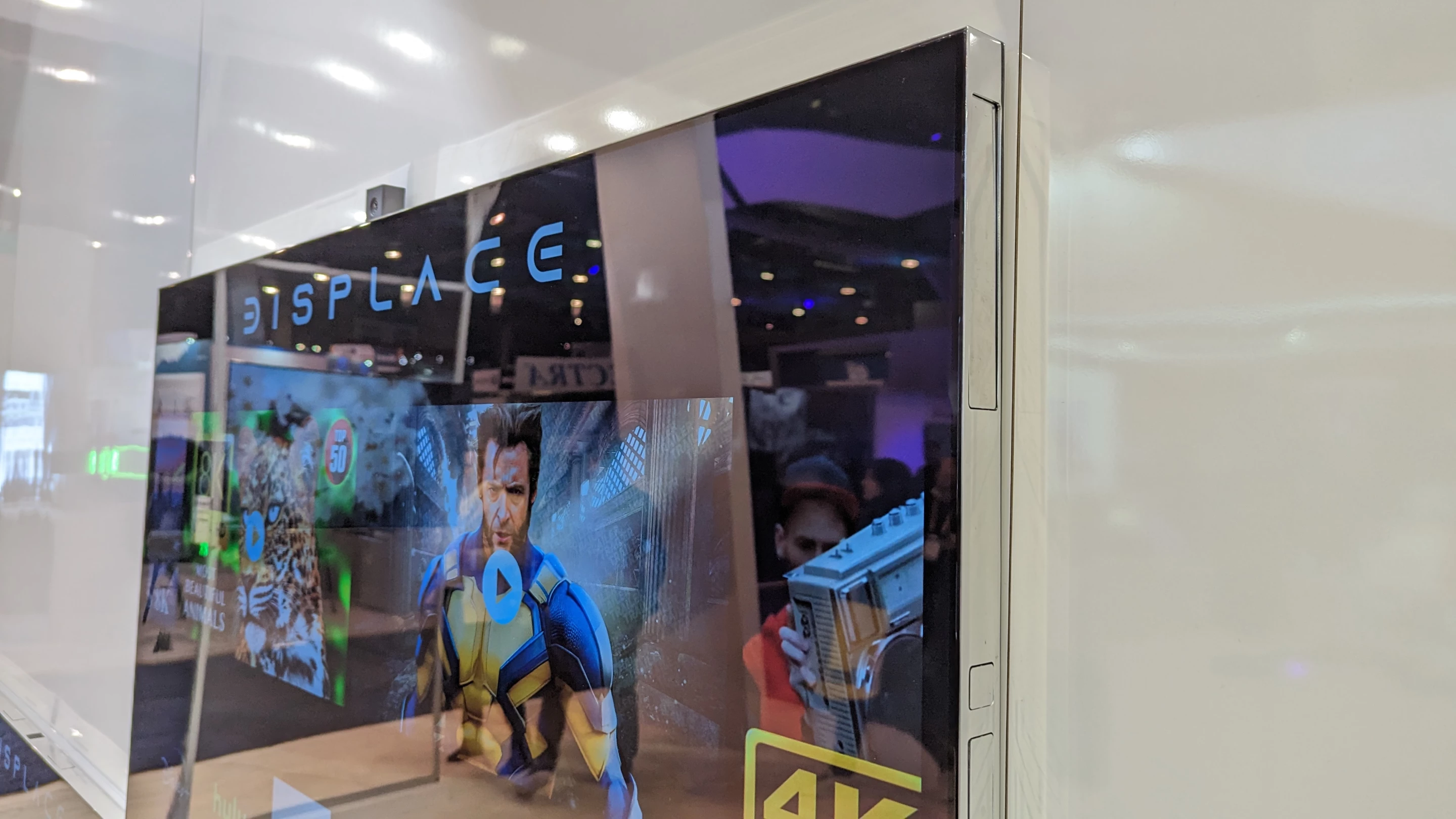At CES 2023, Displace showed how its futuristic, battery-powered 55-inch 4K TV utilizes a special pop-up camera to recognize gesture controls and a proprietary active-loop vacuum seal to adhere itself to walls.
The gesture controls of the DisplaceTV that most caught our eye at the show were the ability to use your finger as a mouse to select particular on-screen channels/options, plus a fancy two-handed flourish to enlarge what’s on one screen to fill all four. By the way, such a configuration – a two-by-two grid of DisplaceTVs – would essentially create an 8K 110-inch TV capable of streaming four different channels at once. Or if you position them on different walls with their respective cameras popped up, you can enable your content to seamlessly follow you around the house.

In addition to gestures, you’ll also be able to control the TV with voice, touch and an app. The display receives all its content from a separate base unit, into which you can plug all your video sources (i.e. cable and streaming boxes, gaming console, Blu-ray player, etc.) somewhere else in the room. Thus your movies and shows stream from that box (potentially hidden from sight) to the actual display(s). In fact, a single base unit can send a signal to up to six different DisplaceTVs. And that’s why the display itself has no wires, plugs, ports or buttons – not even a power button to turn it on.
At less than 20 lb (9 kg), you can transport this svelte telly around the house and stick it to pretty much any smooth surface, including glass, concrete or drywall. Though it can store two batteries in its left side and two more in the right, it only needs one to be fully operational - thus allowing you to top off the other three, if necessary. When juiced up, all four batteries are rated to supply a staggering 180 hours of viewing – essentially a month’s worth of streaming TV and movies for a mind-numbing six hours a day.
Here's a demonstration of the vacuum seal system in action:
If for some reason you forget to charge the batteries before you leave on holiday and the unit is in danger of falling off the wall (since the vacuum seal requires power), the app will notify you and then deploy a series of two countermeasures to stick itself manually to the wall so it doesn’t tragically fall and crash. Apparently, they’ve thought of everything!
To wit, the company’s Founder & CEO, Balaji Krishnan, has quite a background in TV. Back in 2011, the serial entrepreneur founded Snapstick, a consumer device startup that brought the world’s first mobile-to-TV experience to peoples’ homes, and was acquired a few years later by TiVo. And then in 2015, he founded DabKick, which introduced both a smart streaming device and the ability for folks to livestream photos, music and videos all on the same screen.
When forming Displace, Krishnan hadn’t originally set out to create a wireless TV, but rather a series of smart displays around the house.
“We [had to] think backwards to see what are the things required to actually get to this mission," Krishnan revealed to us at the company’s booth at CES. "And we wanted to remove all the friction points that people have with the biggest display you have in your home, which is television.”
So they quite literally cut the cords and created their proprietary hot-swappable battery assembly system. Because as he put it, “You don’t want to be charging this TV every night like an iPad.”

In case you happened to hear about LG’s wireless TV entry, the impressive looking 97-inch Signature OLED M that also made a big splash at CES, several factors differentiate the DisplaceTV. From what we understand, the LG; has a power cord (thus it’s not fully wireless); must be mounted (rather than sticking to walls); isn’t modular; has a base unit that can only control one TV (as opposed to up to six) at a time; and needs to be line of sight to that base unit (giving it a shorter transmission range). Also, the LG’s price hasn’t been disclosed yet, but it’s pretty likely to be well into five figures (since their similarly sized G2 is US$25K).
Displace is currently taking reservations for their systems, each of which includes a base control unit, battery charging unit and four batteries per display. A refundable 10% deposit will lock in the following pricing: $2,999 for one DisplaceTV, $5,399 for two and $8,999 for four.
Two other possible accessories Krishnan mentioned to us are some sort of leveler (which makes sense) and perhaps a separate optional magnetic stand. The company currently expects to ship a limited number of DisplaceTVs in December 2023. So perhaps before the end of the year, you’ll finally be able to watch multiple channels all at once a la Marty McFly’s son from Back to the Future 2.







